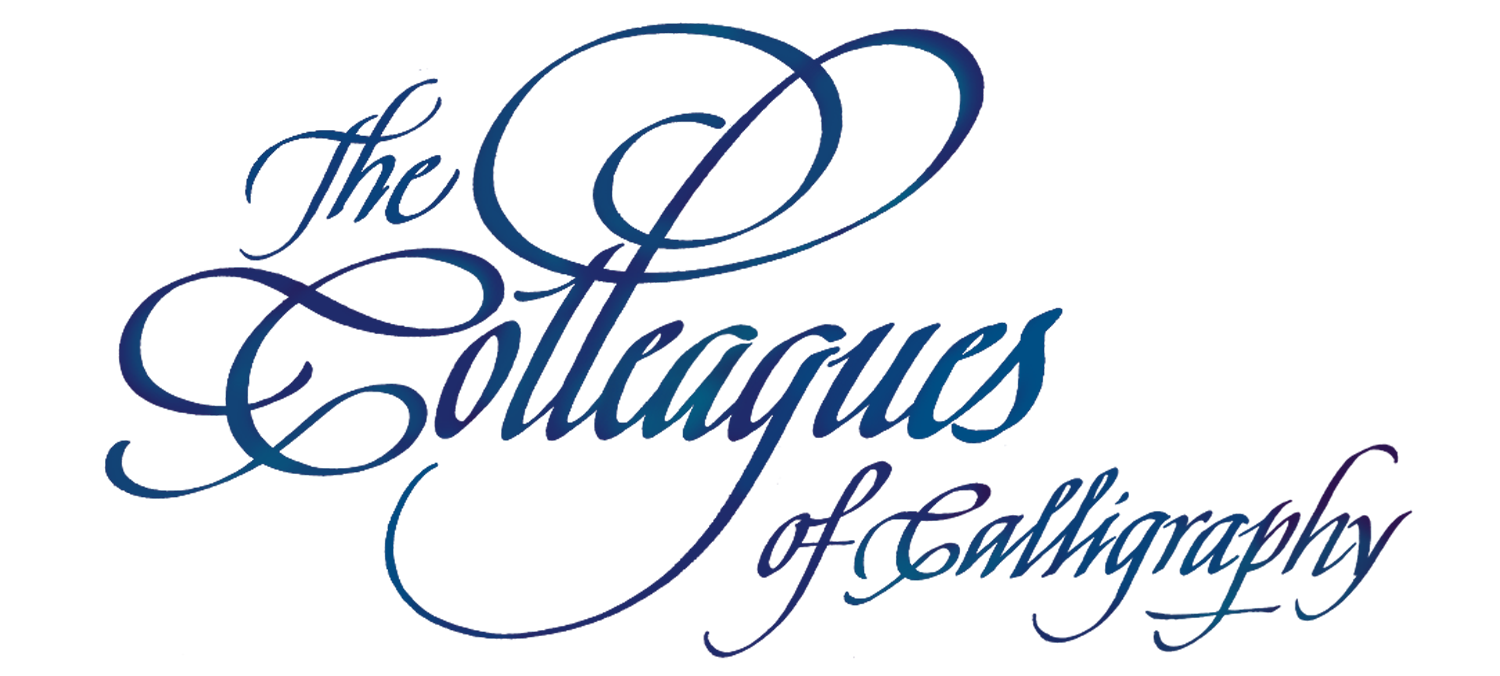During the third weekend of October 2019, the Colleagues of Calligraphy brought in artist and calligrapher Rebecca Wild (rwildart.com) from the Pacific Northwest, and enjoyed an evening program in Minneapolis before she led our Fall Workshop in Edina.
We were able to hear about how Rebecca Wild's grandmother and mother demonstrated the importance of penmanship and served as early influences in her calligraphy and handwriting.
Rebecca's mother, Lila Ruby, had studied the Palmer method of handwriting (later replaced by the Zaner method). Her grandmother, Mabel Riggs Dunfee, who lived to age 101, often sent letters to Rebecca; they were written with exceptional Spencerian penmanship, using a fountain pen. One of the special things Rebecca inherited was the ledger her mother had kept for her grandfather's business. This simple book, full of regular handwritten records, connected one life to the lives of others.
Her cousin Joan Pennington introduced Rebecca Wild to the world of White House Calligraphy and the influence of William E. Tolley. Rebecca started on his team by working on the least profitable certificates, and was later able to move on to more complex projects, including presidential appointments.
After moving from Washington, D.C., to the Pacific Northwest in 1983, Rebecca found a new calligraphic landscape. She discovered that she "only knew classical, but had to learn to play jazz." She eventually settled in Portland, Oregon, where she taught at Portland Community College and Oregon College of Art & Craft for many years.
Rebecca shared stories of how letters and writing connected lives. One particularly notable story was about Ibrahima, from Guinea, West Africa, who took Rebecca Wild's class years ago on Humanist Bookhand. A fonts technician had referred this student to her class, stating it would help him understand and refine nuances in an alphabet that he was working on.
As children in the early 1990's, Ibrahima Barry and his brother chose to create an alphabet for their oral language. They wanted their family and village to be able to read and write. The writing system they created, ADLaM (an acronym representing the first four letters of the alphabet: A, D, L, M), was widely received. It has been used to record the people's history and share their culture. It has been deemed "the alphabet that will save a people from disappearing."
What began as a child's innocent question turned into a movement. ADLaM is taught at more than 300 learning centers worldwide, and has been added to Microsoft Email and various other applications. Read more in an article by the Atlantic.
A second story included a “Cola pen" a friend had gifted her, which she allowed a student named Tim Leigh to try. The pen did not last, and so Tim decided to create a new one. A journalist, with a stash of exotic hardwood in his woodshop, he was able to create a new pen, which quickly became a favorite for Rebecca, the first "Tim's Pen." He went on to create pens as a post-retirement endeavor, and has now sold more than 4,000 (timspens.com).
A third story included an illustration of the Atlantic Monthly quote “Letters seem to me like frozen conversation." A distant Uncle, Roy Taylor, had sent letters to Aunt Edna. A box of these letters, along with various associated ephemera from 1888-1889, fell into Rebecca's possession. Reading them told of history, love, and loneliness. Mail was truly Roy's lifeline to home.
A final story included one of Rebecca's students, Ashley, who came to a difficult realization that she did not know much about her grandfather, and did not know how to ask her grandmother. Ashley decided to pose questions in a letter to her grandmother. This letter asking about her grandfather truly changed her relationship with her grandmother—it began to knit their lives together and make new connections. The pen is mightier than the sword.
Rebecca asked us to consider our own lives. With all our fast-paced activities and electronic communication, are we as connected to one another as we would like to be? It is said, "the demise of handwritten correspondence will have consequences on society." Much like we have the "slow food" movement growing interest—should we also have the "slow writing" movement?
“If today we knew something about the craftsmanship of our own writing it would provide us with a reasonable point of departure for the investigation of a more highly developed art, but very few of us do, and a suspicion arises that there may be something the matter with a people who have become literate and yet have lost the skill of the pen.”--Bernard Leach, A Potter's Book, 1940
The Colleagues of Calligraphy enjoyed our evening of Letter Stories with Rebecca Wild. We discussed how we might apply her ideas and stories to our own lives.
Rebecca encouraged us to start writing letters regularly, if we do not already do so. “Thank You" notes can be a good start. Write someone's name—people love to see their names—and a small note can connect our lives with others.
One of the attendees, Anne, spoke about her research with students on the psychological effects of writing letters. Writing letters to others, that the students were particularly grateful for, had a profound effect on their well-being. Another attendee, Janey, shared that when she has an important piece of mail and needs to ensure delivery, "handwriting gets it there." Other members shared how they have made time in their lives, even with other Colleagues, in order to make letter writing a regular rhythm in life.
As we enter the long Minnesota winter and holiday months, we are grateful to Rebecca Wild and the stories she shared, and the community that we share. We look forward to wielding the pen and sharing ourselves with others with this powerful tool.
For more images from the workshop “Small Art, Big Ideas” led by Rebecca Wild, see our Instagram post.


